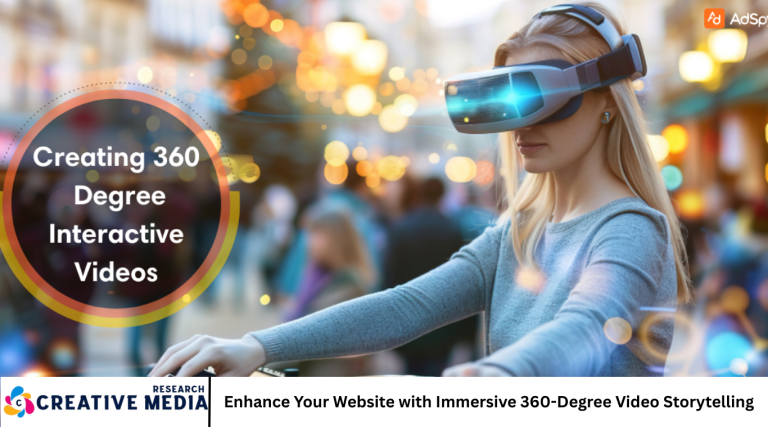In the digital age, capturing and retaining visitor attention on websites has become increasingly challenging. As users become more selective with their online time, brands and content creators must innovate to stand out. One powerful tool emerging in this landscape is 360-degree video storytelling. By offering a fully immersive visual experience, 360-degree videos transport viewers into the heart of the story, allowing them to explore content interactively.
This article explores how immersive 360-degree video storytelling can enhance your website, increase engagement, improve user experience, and provide a competitive edge. We will cover the technology behind 360-degree videos, benefits, best practices for integration, examples, and future trends.
What is 360-Degree Video Storytelling?
Understanding 360-Degree Videos
A 360-degree video captures a scene in every direction simultaneously. Unlike traditional videos with fixed frames, viewers can navigate the video sphere by dragging with a mouse, using touch gestures, or moving a VR headset, exploring different angles and perspectives in real-time.
Storytelling with 360-Degree Videos
360-degree video storytelling transforms passive viewing into an interactive experience. It empowers audiences to explore narratives dynamically, creating deeper emotional connections and memorable interactions.
Why Use 360-Degree Video Storytelling on Your Website?
Immersive User Experience
360-degree videos engage users more deeply by allowing them to control their viewpoint, creating a sense of presence and immersion.
Increased Engagement and Time on Site
Interactive content keeps visitors exploring longer, reducing bounce rates and signaling positive user experience to search engines.
Differentiation and Brand Innovation
Offering cutting-edge technology and storytelling methods sets your website apart from competitors and positions your brand as innovative.
Enhanced Emotional Connection
Immersive stories can evoke stronger emotional responses, fostering brand loyalty and trust.
Versatility Across Industries
From real estate virtual tours to travel experiences, product showcases, and educational content, 360-degree videos have broad applicability.
How to Create and Integrate 360-Degree Video Storytelling on Your Website
Define Your Story and Goals
Identify what story you want to tell and what you want to achieve: brand awareness, product demonstration, customer engagement, or education.
Plan Your Shoot
360-degree video requires specialized cameras or rigs that capture panoramic views. Plan the location, lighting, and scenes carefully to maximize visual impact.
Production and Post-Production
- Use 360-degree cameras like GoPro Max, Insta360, or professional rigs.
- Stitch footage seamlessly in editing software like Adobe Premiere Pro, Final Cut Pro, or specialized 360 editors.
- Add sound design, narration, and interactive hotspots to guide viewers.
Optimize for Web
- Compress videos without losing quality for faster load times.
- Use formats compatible with most browsers (e.g., equirectangular projection).
- Host videos on platforms supporting 360 playback like YouTube, Vimeo, or self-host with players like Video.js or A-Frame.
Embed and Test
Embed the video using appropriate plugins or custom code. Test across devices and browsers to ensure smooth performance and usability.
Promote and Analyze
Promote your immersive videos through social media, newsletters, and SEO. Use analytics to track engagement metrics.
Best Practices for 360-Degree Video Storytelling
Focus on the Viewer’s Journey
Guide viewers through the story with visual cues, narration, or hotspots, preventing them from missing important elements.
Keep Videos Short and Impactful
Attention spans online are short; concise, well-edited videos perform better.
Ensure High Quality
High-resolution, stable footage enhances immersion and professionalism.
Mobile-Friendly Design
Optimize the experience for mobile users who make up a large portion of web traffic.
Accessibility Considerations
Add captions, descriptive audio, and alternative content for users with disabilities.
Industry Use Cases for 360-Degree Video Storytelling
Real Estate and Architecture
Virtual property tours enable potential buyers to explore spaces remotely, saving time and increasing interest.
Travel and Tourism
Showcase destinations immersively, inspiring wanderlust and bookings.
Retail and E-commerce
Display products in 360 views, allowing customers to examine items thoroughly before purchase.
Education and Training
Simulate real-world scenarios for effective learning experiences.
Events and Entertainment
Stream live concerts or performances in 360, offering front-row virtual access.
The Future of 360-Degree Video on Websites
Integration with Virtual and Augmented Reality
As VR and AR devices become mainstream, 360-degree video content will blend seamlessly with immersive environments.
AI-Enhanced Personalization
Artificial intelligence will customize 360 video experiences based on user preferences and behavior.
Interactive Storytelling Evolution
Greater interactivity, branching narratives, and user-generated content will transform storytelling dynamics.
Frequently Asked Questions
What devices can play 360-degree videos?
360-degree videos are viewable on smartphones, tablets, desktops, and VR headsets, with interactive controls suited to each device.
Is 360-degree video compatible with all browsers?
Most modern browsers support 360-degree video playback, but performance can vary. Testing is recommended.
How long should 360-degree videos be?
Aim for 1 to 5 minutes to keep viewers engaged without overwhelming them.
Do I need special skills or equipment to create 360-degree videos?
Basic 360-degree videos can be created with consumer-grade cameras, but professional quality requires expertise in filming and editing.
Can 360-degree videos improve SEO?
Yes, increased engagement and time on site positively impact SEO rankings.
Are there accessibility challenges with 360-degree videos?
Yes, providing captions, audio descriptions, and alternative content improves accessibility.
How do I embed 360-degree videos on my website?
Use platforms like YouTube or Vimeo that support 360 videos, or embed with specialized web players and frameworks.
Conclusion
360-degree video storytelling is a transformative tool that can significantly enhance your website’s user experience and engagement. By immersing visitors in interactive, panoramic narratives, you create memorable connections that boost brand loyalty and conversion rates.With advancements in technology making 360-degree video creation and integration more accessible, now is the perfect time to explore this dynamic medium. Embrace immersive storytelling to stand out in the crowded digital landscape and captivate your audience like never before.

